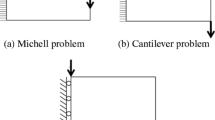Abstract
In the nested approach to structural optimization, most of the computational effort is invested in the solution of the analysis equations. In this study, it is suggested to reduce this computational cost by using an approximation to the solution of the analysis problem, generated by a Krylov subspace iterative solver. By choosing convergence criteria for the iterative solver that are strongly related to the optimization objective and to the design sensitivities, it is possible to terminate the iterative solution of the nested equations earlier compared to traditional convergence measures. The approximation is computationally shown to be sufficiently accurate for the purpose of optimization though the nested equation system is not necessarily solved accurately. The approach is tested on several large-scale topology optimization problems, including minimum compliance problems and compliant mechanism design problems. The optimized designs are practically identical while the time spent on the analysis is reduced significantly.
Similar content being viewed by others
References
Amir O, Bendsøe MP, Sigmund O (2009a) Approximate reanalysis in topology optimization. Int J Numer Methods Eng 78:1474–1491
Amir O, Stolpe M, Sigmund O (2009b) Efficient use of iterative solvers in nested topology optimization. In: Proceedings of the 8th world congress on structural and multidisciplinary optimization, Lisbon, Portugal
Bendsøe MP (1989) Optimal shape design as a material distribution problem. Struct Optim 1:193–202
Bendsøe MP, Kikuchi N (1988) Generating optimal topologies in structural design using a homogenization method. Comput Methods Appl Mech Eng 71:197–224
Bendsøe MP, Sigmund O (2003) Topology optimization—theory, methods and applications. Springer, Berlin
Bourdin B (2001) Filters in topology optimization. Int J Numer Methods Eng 50:2143–2158
Bruns TE, Tortorelli DA (2001) Topology optimization of non-linear elastic structures and compliant mechanisms. Comput Methods Appl Mech Eng 190:3443–3459
Evgrafov A, Rupp CJ, Maute K, Dunn ML (2008) Large-scale parallel topology optimization using a dual-primal substructuring solver. Struct Multidisc Optim 36:329–345
Hestenes MR, Stiefel E (1952) Methods of conjugate gradients for solving linear systems. J Res Natl Bur Stand 49(6):409–436
Kim TS, Kim JE, Kim YY (2004) Parallelized structural topology optimization for eigenvalue problems. Int J Solids Struct 41:2623–2641
Kirsch U (1991) Reduced basis approximations of structural displacements for optimal design. AIAA J 29:1751–1758
Mahdavi A, Balaji R, Freckerand M, Mockensturm EM (2006) Topology optimization of 2D continua for minimum compliance using parallel computing. Struct Multidisc Optim 32:121–132
Meijerink JA, van der Vorst HA (1977) An iterative solution method for linear equation systems of which the coefficient matrix is a symmetric M-matrix. Math Comput 31:148–162
O’Leary DP (1980) The block conjugate gradient algorithm and related methods. Linear Algebra Appl 29:293–322
Saad Y (2003) Iterative methods for sparse linear systems, 2nd edn. SIAM, Philadelphia
Sigmund O (1997) On the design of compliant mechanisms using topology optimization. Mech Des Struct Mach 25:493–524
Sigmund O (2001) A 99 line topology optimization code written in matlab. Struct Multidisc Optim 21:120–127
Svanberg K (1987) The method of moving asymptotes—a new method for structural optimization. Int J Numer Methods Eng 24:359–373
van der Sluis A, van der Vorst HA (1986) The rate of convergence of conjugate gradients. Numer Math 48:543–560
Vemaganti K, Lawrence EW (2005) Parallel methods for optimality criteria-based topology optimization. Comput Methods Appl Mech Eng 194:3637–3667
Wang S, de Sturler E, Paulino GH (2007) Large-scale topology optimization using preconditioned Krylov subspace methods with recycling. Int J Numer Methods Eng 69:2441–2468
Author information
Authors and Affiliations
Corresponding author
Additional information
This is an extended version of a paper presented at WCSMO-8, held in Lisbon, Portugal, June 2009.
Rights and permissions
About this article
Cite this article
Amir, O., Stolpe, M. & Sigmund, O. Efficient use of iterative solvers in nested topology optimization. Struct Multidisc Optim 42, 55–72 (2010). https://doi.org/10.1007/s00158-009-0463-4
Received:
Revised:
Accepted:
Published:
Issue Date:
DOI: https://doi.org/10.1007/s00158-009-0463-4




